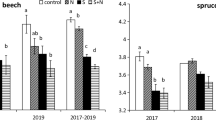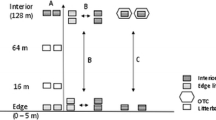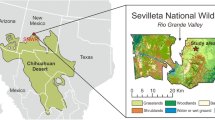Abstract
Open-top chamber (OTC) climate change simulation was used to predict the potential effects of climate change on biogeochemistry, including: 1) soil decomposition of three litter types (trembling aspen (Populus tremuloides Michx.), black spruce (Picea mariana (Miller) BSP), and Sphagnum); 2) soil nutrient supply rates, and; 3) soil acidity. We assessed the effects of OTCs on these biogeochemical factors in the presence or absence of Sphagnum moss substrate at post-fire and logging sites, in the transitional mixedwood-boreal zone of northwestern Quebec. Higher air temperatures and cooler, drier soils created by the OTC treatment resulted in lower decomposition rates and a higher C:N ratio of aspen litter, and lower Ca concentrations of the Sphagnum litter after 14 months of incubation, as well as lower K concentrations of spruce litter after 24 month incubation. There were no effects of the OTC treatment on decomposition rates for Sphagnum and spruce litter. The nutrient supply rates of Ca and Mg were consistently lower in the OTCs. The supply rates of N were significantly higher in the control plots at the logging site than at any other combination of the OTC treatment and disturbance site. Soil pH was lower in the OTCs by the end of the growing seasons in 2006 and 2007. The results suggest that the impact of climatic changes, as simulated by the OTC treatment, on the soil system of mixedwood-boreal post-disturbance sites is likely to affect biogeochemical processes such as nutrient supply rates and the soil pH, but the effects on decomposition may be minimal.

Similar content being viewed by others
References
ACIA (2004) Impacts of a warming arctic: arctic climate impact assessment. Cambridge University Press
Aerts R (1997) Climate, leaf litter chemistry and leaf litter decomposition in terrestrial ecosystems: A triangular relationship. Oikos 79:439–449
Aerts R (2006) The freezer defrosting: global warming and litter decomposition rates in cold biomes. J Ecol 94:713–724
Ågren GI, McMurtrie RE, Parton WJ, Shugart HH (1991) State-of-the-art of models of production-decomposition linkages in conifer and grassland ecosystems. Ecol Appl 1:118–138
Alban DH, Perala DA, Schlaegel BE (1978) Biomass and nutrient distribution in aspen, pine, and spruce stands on same soil type in Minnesota. Can J For Res 8:290–299
Belyea LR (1996) Separating the effects of litter quality and microenvironment on decomposition rates in a patterned peatland. Oikos 77:529–539
Bergeron Y, Gauthier S, Flannigan M, Kafka V (2004) Fire regimes at the transition between mixedwood and coniferous boreal forest in Northwestern Quebec. Ecology 85:1916–1932
Dabros A (2008) Effects of simulated climate change on post-disturbance Populus tremuloides—Picea mariana ecosystems in northwestern Quebec. PhD thesis, McGill University
Dahlgren RA, Driscoll CT (1994) The effects of whole-tree clear-cutting on soil processes at the Hubbard Brook Experimental Forest, New-Hampshire, USA. Plant Soil 158:239–262
Decker KLM, Wang D, Waite C, Scherbatskoy T (2003) Snow removal and ambient air temperature effects on forest soil temperatures in Northern Vermont. Soil Sci Soc of Am J 67:1234–1242
Dorrepaal E, Aerts R, Cornelissen JHC, Van Logtestijn RSP, Callaghan TV (2006) Sphagnum modifies climate-change impacts on subarctic vascular bog plants. Funct Ecol 20:31–41
Groffman PM, Driscoll CT, Fahey TJ, Hardy JP, Fitzhugh RD, Tierney GL (2001) Colder soils in a warmer world: a snow manipulation study in a northern hardwood forest ecosystem. Biogeochemistry 56:135–150
Hardy JP, Groffman PM, Fitzhugh RD, Henry KS, Welman AT, Demers JD, Fahey TJ, Driscoll CT, Tierney GL, Nolan S (2001) Snow depth manipulation and its influence on soil frost and water dynamics in a northern hardwood forest. Biogeochemistry 56:151–174
Hobbie SE (1996) Temperature and plant species control over litter decomposition in Alaskan tundra. Ecol Monogr 66:503–522
Hobbie SE, Gough L (2004) Litter decomposition in moist acidic and non-acidic tundra with different glacial histories. Oecologia 140:113–124
Hollister RD (1998) Response of wet meadow tundra to interannual and manipulated temperature variation: implications for climate change research. MSc thesis, Michigan State University
IPCC: Intergovernmental Panel on Climate Change (2007) The Physical Science Basis. Contribution of Working Group I to the Fourth Assessment Report of the Intergovernmental Panel on Climate Change. In: Solomon S, Qin D, Manning M, Chen Z, Marquis M, Averyt KB, Tignor M, Miller HL (eds) Cambridge University Press, Cambridge, UK and New York, NY, USA, p 996
Kirschbaum MU (2000) Will changes in soil organic matter act as a positive or negative feedback on global warming? Biogeochemistry 48:21–51
Lefort P (2003) Ecology and management of Claybelt forests: a knowledge synthesis. Lake Abitibi Model Forest Network, Cochrane, Ontario, Canada
Marion GM, Pidgeon DE (1992) Passive techniques for manipulating field soil temperatures. Special Report 92-14. U.S. Army Crops of Engineers, Cold Regions Research & Engineering Laboratory
McClaugherty CA, Pastor J, Aber JD, Melillo JM (1985) Forest litter decomposition in relation to soil nitrogen dynamics and litter quality. Ecology 66:266–275
Moore TR, Bubier JL, Bledzki L (2007) Litter decomposition in temperate peatland ecosystems: The effect of substrate and site. Ecosystems 10:949–963
Parkinson JA, Allen SE (1975) Wet oxidation procedure suitable for determination of nitrogen and mineral nutrients in biological material. Commun Soil Sci Plant Anal 6:1–11
Plant Root Simulator (PRS™) Operations Manual (2004) Applying Research Solutions to Agriculture & the Environment. Western Ag Innovations Inc., Saskatoon, Saskatchewan
Rosenberg NJ, Blad BL, Verma SB (1983) Microclimate; the biological environment. Wiley, New York, NY, USA
Rustad LE, Campbell JL, Marion GM, Norby RJ, Mitchell MJ, Hartley AE, Cornelissen JHC, Gurevitch J (2001) A meta-analysis of the response of soil respiration, net nitrogen mineralization, and aboveground plant growth to experimental ecosystem warming. Oecologia 126:543–562
SAS Institute Inc. (2007) SAS Language and Procedures: Usage. Version 9.1, SAS Institute, Cary, North Carolina, USA
StatSoft, Inc. (2001) STATISTICA (data analysis software system). Version 6. Tulsa, OK, USA
Swift MJ, Heal OW, Anderson JM (1979) Decomposition in terrestrial ecosystems. University of California Press, Berkeley, California, USA
Trofymow JA, and the CIDET Working Group (1998) The Canadian Intersite Decomposition Experiment. Canadian Forest Service Information Report BC-X-378, Natural Resources Canada, Pacific Forestry Centre, Victoria, B.C., Canada
Turetsky MR (2003) The role of bryophytes in carbon and nitrogen cycling. Bryologist 106:395–409
Van Cleve K, Oliver L, Schlentner R, Viereck LA, Dyrness CT (1983) Productivity and nutrient cycling in taiga forest ecosystems. Can J For Res 13:747–766
Van Cleve K, Oechel WC, Hom JL (1990) Response of black spruce (Picea mariana) ecosystems to soil temperature modification in Interior Alaska. Can J For Res 20:1530–1535
Zhang TJ (2005) Influence of the seasonal snow cover on the ground thermal regime: An overview. Rev of Geophysics 43: Art. No. RG4002
Acknowledgements
We would like to thank L. Bissonnette, K. Bona, D. Dabros, L. Dabros, B. Gélinas, H. Lalande and A. Murphy for field and laboratory assistance; and E. and H. Coriveau, J.-G. and C. Harvey and M.-P. Bluteau for logistic support while staying in James Bay. Financial support for this project was provided by Sustainable Forest Management Network and Natural Sciences and Engineering Research Council of Canada.
Author information
Authors and Affiliations
Corresponding author
Additional information
Responsible Editor: Per Ambus.
Rights and permissions
About this article
Cite this article
Dabros, A., Fyles, J.W. Effects of open-top chambers and substrate type on biogeochemical processes at disturbed boreal forest sites in northwestern Quebec. Plant Soil 327, 465–479 (2010). https://doi.org/10.1007/s11104-009-0077-z
Received:
Accepted:
Published:
Issue Date:
DOI: https://doi.org/10.1007/s11104-009-0077-z




